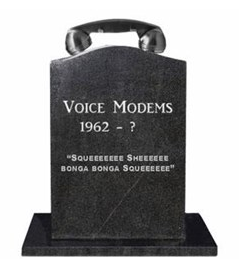 When I first came to Trihedral, I was surprised to learn that voice modems were still widely used in the HMI and SCADA industries. Though the days of wedging your phone receiver into a foam cradle are long gone, the name still conjures up the sounds of chirps, bleeps, and bongs they make as they translate analog information into digital. As high-speed networks became our preferred method of web surfing, the use of this technology has steeply declined.
When I first came to Trihedral, I was surprised to learn that voice modems were still widely used in the HMI and SCADA industries. Though the days of wedging your phone receiver into a foam cradle are long gone, the name still conjures up the sounds of chirps, bleeps, and bongs they make as they translate analog information into digital. As high-speed networks became our preferred method of web surfing, the use of this technology has steeply declined.
Why do we still use modems?
In control systems, modems still play an important role. For example, standard modems allow SCADA applications to cheaply connect to widely dispersed I/O and allow SCADA clients and servers to communicate in applications that don’t allow internet access. Voice modems are used primarily to play wave files for dissemination by phone but can also support text-to-speech alarm information. VTScada’s native Alarm Notification System uses this technology to call authorized users and allow them to hear and acknowledge active alarms. Users can also dial in and listen to real time process information. (VTScada additionally supports alarm dissemination via SMS text message, email, and pagers but these do not require voice modems.)
The problem with modems.
Finding the right modems for text-to-speech SCADA alarm notifications is challenging. In recent years, manufacturers are offering fewer models and developing fewer device drivers. Many available devices are not compatible with Windows 10 or Server 2016. Our in-house software support team spends a significant amount of their time helping customers choose, configure, and troubleshoot devices for their VTScada systems. The list of applicable voice modems must be constantly updated as manufacturers discontinue product lines.
The problem with data over analog lines.
Trihedral software developer, Greg Hicks, described for me another problem with these devices. “Using modems for data is getting more and more difficult as most telecom providers assume that only voice is going to be used on analog lines, and then only as far as the fibre-op modem, or the local concentrator (e.g., on the telephone pole). Analog lines are now often converted to VOIP at some point using codecs that work well for voice, but not very well for data. As a result, using an analog line from your telephone company will not necessarily mean that your modem will work for data. I think we are going to hit a point at which no one can make money selling modems, at which point there will be no suppliers, but whether that happens next year or in ten years, I have no idea.”
Modems don’t work with virtual machines.
Modems are also problematic for SCADA systems running on virtual machines where multiple Windows operating systems run concurrently on a single PC. The limited number of ports makes it almost impossible to configure separate modems for each running OS. This means that voice-to-speech alarm notifications cannot fail over from one virtual machine to another. This is a big problem for cloud-based hosted SCADA systems which commonly rely on virtual machine architecture.
What is the alternative to modem hardware?In July, we released VTScada 11.3 which includes an interface to the Twilio messaging system. This web-based communication platform (licensed separately) allows you to send spoken alarm notifications to operators’ phones with fewer troubleshooting and compatibility issues than traditional modems hardware. However, Twilio is only an option for VTScada applications that can access the Internet. For this reason, modems aren’t going to disappear any time soon. This alarm delivery model does provide a way forward for the growing number of VTScada hosted providers as well as customers who are working hard to support a dead-end technology.
About the Author
Christopher Little, Sales and Marketing, Trihedral – For over ten years Chris has been producing articles, case studies, and videos covering topics related to industrial monitoring and control. His work has been featured in a variety of industry-specific publications.
